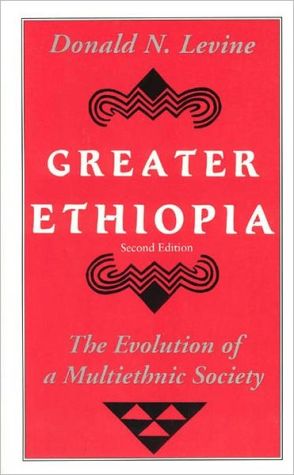

 |

|

The average rating for Greater Ethiopia: The Evolution of a Multiethnic Society based on 2 reviews is 4.5 stars.
Review # 1 was written on 2017-11-11 00:00:00 Edmund Wade Edmund Wade"What makes Ethiopia Ethiopian ?" Throughout history there have been large traditional polities inhabited by a number of different ethnic groups. Such countries exist right up to our own days, but their number has shrunk. The Austro-Hungarian Empire, the Ottomans, Russia and its offshoot the USSR, and the Incan Tahuantinsuyu are examples of such political entities in the past; Iran, India, Myanmar, and Indonesia may be examined today. Ethiopia is another. Many ethnic groups, speaking a large number of different languages, practicing several religions, and living in a wide variety of ecological zones following different styles of life, inhabited the country we know as Ethiopia (and Eritrea as well). Is there anything that such conglomerations of people have in common ? Or is there really no reason why they shouldn't break up as did the Soviet Union or Ottoman Turkey ? They could form small, ethnically homogenous states. (or could they ?) Perhaps, on the other hand, there IS something they all have in common. Levine, in this highly-interesting overview of Ethiopia and its multiple cultures, tries to establish what exactly the many ethnic groups of Ethiopia do share. Why can we look at it as a 'culture area' and not just a bunch of unrelated peoples and tribes? Unfortunately for him, soon after his first edition got published, Ethiopia broke up into a welter of conflicting groups, most ethnically based. One could comment that it seemed they didn't have much in common. It took many years and the loss of Eritrea before things quieted down once more and Ethiopia began to develop into a modern state. He tried to address this situation in the second edition. No doubt the peoples of Ethiopia DO have commonalities, starting with a shared history and the tendency to use Amharic as a lingua franca. The many small kingdoms that existed up to the mid-19th century modeled their rule on the Amhara version, claiming descent from Solomon etc. Trade and even warfare brought all the peoples into contact, many ritual practices, food taboos, and ideas about the supernatural existed across ethnic lines, some peoples (ex. Oromo) changed their religions, practices, or lifestyles as they came into contact with others. Finally, though fighting amongst groups was more or less endemic, they would unite to oppose external aggression. GREATER ETHIOPIA is also an attempt to describe the chief elements of Ethiopian society, both Amhara and Oromo (along with a bit about others) to establish what the overarching culture of the Ethiopian culture area might consist of. It was a tough task to undertake and it seems to me that Levine has accomplished it very well. Perhaps more emphasis might have been put on Islam and the Muslim segment of the population. On occasion, he seems to fall back on sociological jargon from Talcott Parsons and S.N. Eisenstadt which may not have stood the test of time, but never mind, this book, like his "Wax and Gold" must be read by anyone seriously interested in Ethiopia. |
Review # 2 was written on 2020-04-19 00:00:00 Romel Wrighton Romel WrightonIn the midst of ethnic, religious, linguistic, and cultural diversity, what are the driving forces that allow Ethiopian or "Habeshan" culture to be considered a single entity? And what are the factors that have allowed Ethiopia to maintain its independence when the remainder of Africa fell to colonization? Levine attempts to answer these questions in this short, yet densely information-packed book. After providing an overview of the various ethnocultural groups of Ethiopia and a description of the various tropes that have historically defined outsiders views of Ethiopia--typically including "mysterious land" "land of desperate poverty", "ethnological museum", "outpost of semitic civilization" etc., Levine turns to a specific analysis of the largest ethnocultural influences within Ethiopian culture. The main portion of Levine's work focuses on the influence of the various national scripts that have contributed to the Greater Ethiopian culture --the Amhara Script, heavily influenced by the Kibre Negest ("Book of Kings") and its role in the formation of the Solomonid Dynasty which controlled much of Greater Ethiopia from the end of the first Millennium until the 20th Century, the Tigrean script/culture--with its strong links/affinity to the Amharic culture, and the Oromo script/culture (often referred to here by Levine with the outdated term "Galla") defined by an egalitarian collectivism and the role of the intricate Gada system in defining social roles in the Oromo. Levine makes the point that it is precisely because of the Oromo lack of a defined cultural canon or written tradition that has allowed an openness to other cultural influences and therefore facilitated their unity within the Amhara-Tigrean culture to form a "Greater Ethiopian" culture that has unified in resistance to outside incursion from both European, Arab, and other African sources. Although Levine relies a little too heavily on academic jargon from scholars such as Talcott Parsons (his theory of social organization informs much of Levine's approach/perspective), this is overall a solid, if somewhat dated and essentialist work in describing the balance of ethnic (Amhara, Tigrean, Oromo, Somali), religious (Orthodox Christian, Muslim, Jewish/Falasha, Evangelical/Pentecostal Christian), and linguistic elements that make up a truly "Greater Ethiopian" culture. |
CAN'T FIND WHAT YOU'RE LOOKING FOR? CLICK HERE!!!